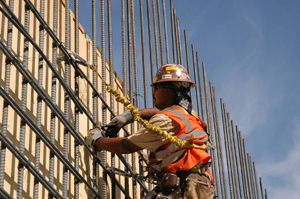Contractors also shouldn’t assume that Latino workers understand safety messages as easily as their English-speaking colleagues. Brian Poliafico, assistant vice president of risk engineering for insurance underwriter XL Catlin, has found the Red Angle learning system to be particularly helpful in building a construction-oriented Spanish vocabulary.
“It helps you make a small personal connection via casual conversation, from which you can then talk about safety issues,” Poliafico explains. “You may be anything but fluent, but the fact that you care enough to try is usually enough to gain credibility.”
In the best safety cultures, communication flows both ways. An employee’s onsite perceptions may often prove more insightful than any rulebook or advisory guidelines, particularly when it comes to enforcing safety rules. That’s why listening and an open mind are good skills to have.
“Safety people have a lot of technical knowledge, but they don’t always know how the trades do their jobs, especially on the individual level,” admits Lyons. He says he once spotted an electrician who wasn’t wearing the required safety gloves. The electrician told him that the fingers of the gloves were too bulky to perform certain tasks.
“The answer was simply to buy him some gloves that were more flexible, or leave his fingertips exposed to do tactile work while still protecting the rest of the hand,” he says. “Had we just gone by the book, we would have had a disgruntled worker who didn’t get much done or worked without gloves when he thought no one was watching.”
In other situations, the best way to reinforce a safety message is to remind workers “what’s in it for them” by following specific rules and procedures. While some companies turn compliance into competition, few incentives are more powerful than family.
“People may or may not care about efficiency,” Lyons says, “but every one of them wants to go home at night.”
Spotlighting exemplary employees is another hallmark of a good safety culture, combining recognition with a catalyst that inspires other employees to do the same.
“A site supervisor can use examples of work being done well as the theme for the daily safety huddle,” Tolbert says. “They can discuss the barriers that might be keeping other workers from doing things the same way and find ways to eliminate them.”
These tips are a good start toward instilling and sustaining a good safety culture. But they are just that: a start. Just as a pervasive emphasis on safety doesn’t materialize overnight, experts say that project and safety managers must develop and continually hone their communication skills to stay relevant in the work force. They also need to adapt as the jobsites, risks and task requirements change.
Essentially, it’s no different from a jobsite itself, where completing today’s work without injury or disruption doesn’t guarantee the same result tomorrow, safety experts say.
“A contractor needs to put energy behind safety and take ownership of it,” Poliafico explains. “It’s hard, and it’s a work in progress.”




Post a comment to this article
Report Abusive Comment